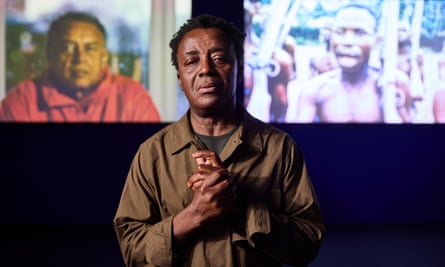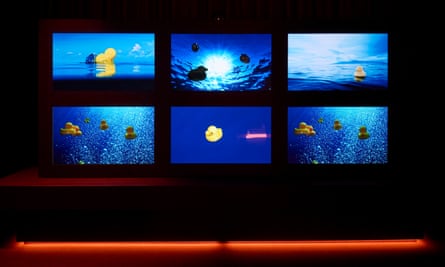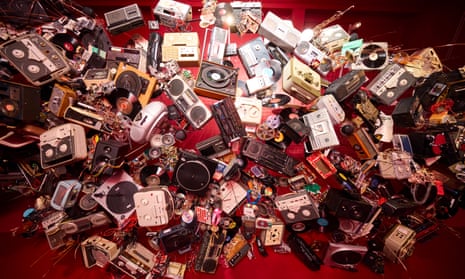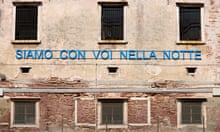Trucks pass by spewing clouds of insecticide that fumigate a poor neighbourhood. A small child, stoic and resigned, gets the treatment too. A carriage clock and an old watch drown on a riverbed, along with old master drawings and paintings distorted by the rills in the stream, and avuncular 1970s TV ecologist David Bellamy explains global warming in some old degraded footage. A container ship founders, its cargo shifting. Sound and image do all the work in John Akomfrah’s Listening All Night to the Rain, which fills the British pavilion at the Venice Biennale. I was there two hours and still feel I’ve only seen snatches, the story constantly slipping away from me and leading me on, via continual swerves and jumps and shifts, from moment to moment, screen to screen and room to room. Overwhelmed, I’m left gasping.
As soon as the eye settles on one thing, we are swept away again. A man sleeps beside pictures of boy soldiers. One of them once might have been him. Jellyfish rise through water in green light, and a white woman in pearls and gloves waves from a car at dutiful crowds of black faces. A man waits at a lonely bus stop in the Scottish highlands beside a road sign warning of otters crossing. How do we go from here to images of Patrice Lumumba, first prime minister of the Democratic Republic of the Congo, before his assassination? A waving placard tells us that colonialists are doomed.

Using archival and found film footage, along with set-pieces staged in the landscape, the work leaves me entranced and unsettled. Even though Akomfrah has organised his material into a sequence of cantos, or chapters, which run together in the mind as we pass through the different rooms. Their sober floor and wall colours – Rothko reds and cinnamons, tenebrous darks and oceanic blues – add to a sense of being both cocooned and disquieted. The soundscape is more than cacophony, though. A text printed above the entrance to one room quotes 20th-century US composer Pauline Oliveros, who said: “Listen to everything until it all belongs together and you are part of it.” And so it is here.
Oliveros promoted what she called “deep listening” and Akomfrah encourages a deep dive here. Making us enter via the pavilion’s basement, he brings us to the top of an unfamiliar staircase where a jumble of old radios, reel-to-reel tape recorders, decks, boomboxes, vinyl discs, dangling wires and festoons of magnetic audio tape hang from the ceiling. Voices from the ether come and go.
A compass, boxed on the foreshore, sits amid the bladderwrack among barnacled wooden boats. Between the hawsers, spars and fish crates are pictures of brutalised black men and women, damning evidence of colonial misdeeds commemorated in black and white photographs. A man looks at a calm sea loch, then he’s up to his waist in the rising tide.
Black workers are at their machines in a Midlands bike factory, where the wheels spin like spools. Rooms are advertised to rent. Europeans Only. No Dogs. No Blacks. No Irish. Sorry No Coloureds. Boxes of jewels, standard lamps and tellies are out on the street, as if the bailiffs have been round. Hikers in all-weather anoraks carry kitchen chairs across the landscape and a weather balloon is launched from the arctic ice. Plastic ducks bob to the ocean surface, stupidly benign.
If you start unpacking it all, your work will never be done. Akomfrah’s earlier film installations – from Handsworth Songs (made with the Black Audio Film Collective in 1986) and his 2012 film portrait of cultural thinker Stuart Hall – were tremendous. More recent works, with their costume set pieces and natural history footage, their examinations of the colonial experiences of exile and diaspora, globalisation and the interconnectedness of politics and ecology, have sometimes threatened to replace surprise and originality with a familiarity that has bordered on cliche.

Maybe I have just seen too much. All those stranded clocks and all that drowned furniture had been beginning to get to me. Listening All Night to the Rain ups the ante – and Akomfrah uses some of his more familiar tropes as counterpoint in a nightmare of endless returns, not least to his decades-long themes and preoccupations. With its bigger histories and small vignettes, its lurches from the rock pool and the riverbed to scenes of insurrection, violence and racism, Akomfrah takes us on a magnificent and awful journey through six interconnecting, room-sized film installations (as well as to screens hung across the pavilion’s portico). Their repetitions have now achieved a cumulative power greater than the sum of the exhibition’s parts. His current work for Venice feels like a summation. Listening All Night to the Rain is more than immersive. It is unhinging, sorrowful and utterly captivating.








